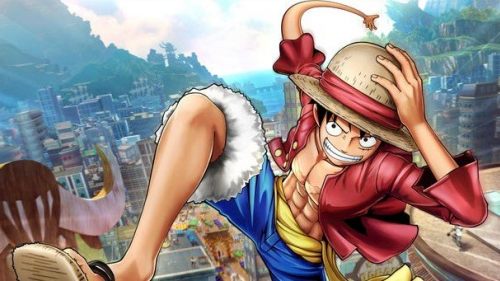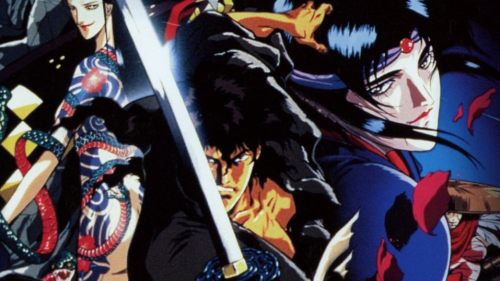The Hybrid Worlds Of Shinichirō Watanabe
As someone who believes in the ‘universal language’ of music and draws from that in creating his shows, it’s no wonder Shinichirō Watanabe has built a reputation as a creator of ambitious anime that’s as entertaining as it is difficult to pin down. In two decades of work, Watanabe has become known for eclectic and distinctive combinations of Japanese and American culture, with design and music heavily inspired by a variety of international artists - for example, the concept for his 2016 show Terror In Resonance sprung from his listening to Sigur Rós. It’s for this reason that his work is broadly considered good ‘gateway’ anime, mixing elements familiar to Western audiences into idiosyncratic shows that are alternatively soulful and silly.
The most famous and beloved example of this is his debut show and first solo directorial venture Cowboy Bebop (his debut was as co-director on Macross Plus, another world emphasising the importance of pop music). The very title suggests fusion - a naming trend of his shows that continues through to Space Dandy. Born from a synthesis of various genres and styles beloved by the creative team, not least of all the Western, sci-fi, and noir with the musical stylings of jazz, funk, soul, Cowboy Bebop unfolds as something embodying all of those genres, but also something new.
The show takes place among a colonised star system, humans having mostly left behind a ruined and destitute Earth. Still, humanity persists, with even the colonised asteroids and planets bearing familiar looks and names; for starters the asteroid where the first episode, ‘Asteroid Blues’, takes place is named Tijuana. It’s a series of mostly self-contained stories, each slowly build out the pasts that each of the main cast is fleeing, building a melancholic tone into proceedings.
Each episode homages everything from heroic bloodshed films to Tao Buddhism, Bruce Lee’s philosophy and athletic ability, the looks of the iconic actor Yusaku Matsuda - and that’s just through Watanabe and Toshihiro Kawamoto’s design of the main character, Spike Spiegel.
The opening theme, ‘Tank!’, is a blaring and catchy introduction to what is so great about Yoko Kanno and her band The Seatbelts’ exceptional score. Mixing rococo drums, erratic horns and rip-roaring solos, old styles collide until something new and exciting emerges. The rest of the show embodies this wild, free-flowing nature, from the wild storyboarding to the unpredictable plotting, to the way the characters simply roll through life. The opening credits, which visually recall the colour palettes of jazz album covers themselves, have text plastered all over the background, detailing both the history of jazz and the history of the crew of the Bebop. Amongst the text is what could be called the show’s mission statement, which proclaims: “…the work, which becomes a new genre itself, will be called Cowboy Bebop”.
By contrast, his follow-up show Samurai Champloo leans harder into more clear-cut duality, blending and contrasting contemporary counterculture and a historical setting. It’s essentially a chanbara (read: samurai swashbuckler) story through a lens of hip-hop and street style culture, and makes for a different sort of combination than the smorgasbord of influences that drove Bebop.
Champloo tells the story of the mismatched trio of the vagrant Mugen, the ronin Jin and orphaned Fuu, who employs the other two to help her on her search for the ‘samurai who smells of sunflowers’. It’s littered with various anachronisms such as the use of modern slang, Mugen’s fighting style that emulates breakdance, Jin’s glasses and its instrumental hip-hop score by Nujabes and Forces of Nature, lending its scenes style, urgency and a connection to the future. The series opens on a small snapshot of modern day Tokyo, before rewinding several hundred years to the same place, during the Edo period of Japan. This odd coupling of genre and culture lives in every formal element of the show from the jump, with the very first episode pieced together through transitions and cuts that emulate record scratches.
Some episodes lean harder into this tension than others, such as “The War of the Words”, in which the gang travels to Hiroshima and encounters a group of graffiti artists who were former students of a local dojo. The episode tells a faux history of graffiti, a form of art closely associated with hip-hop, and relocates the origin of the contemporary style born from urban areas of the US to Edo era Hiroshima, and combines it with philosophy on the power of words, calligraphy and art. The boys doing the graffiti tagging are designed with facial piercings and more modern clothing and punk-ish hairstyles. Jin, who knew their father, assumes that the boys are walking the wrong path, but later concludes that they’re exercising a spiritual practice of their own through their art, one that the older generation needs to make an effort to understand and appreciate.
The show’s fast and loose approach to history is pushed to its breaking point in ‘Baseball Blues’, an absurd episode surrounding a (very deadly) baseball game between a ragtag group of Japanese players - made up of Mugen, Jin, Fuu, a ninja, an old man, a dog, and a member of the secret police - against a team from an American spice trading company. The latter is lead by a character named and modeled after Alexander Cartwright, the ‘father of baseball’, and Matthew C. Perry, a Commodore of the US Navy who played a substantial role in opening Japan to the West through the ending of the national isolation policy.
The episode is goofy, but also mixes in funny and thoughtful reference to both the history of orientalism, Japanese nationalism and isolationism, and America’s colonialist past. This episode serves as the most extreme example of the show’s flagrant playfulness with historical accuracy, that rather paradoxically could be seen as educational, in a sense. It introduces the viewers to elements of Japanese history that they otherwise may not have heard of, while inviting further exploration and comparisons between contemporary and early modern-era Japanese culture.
Watanabe’s usual balance between seriousness and silliness tipped entirely towards the wacky with his 2014 show Space Dandy, which has a high concept similar to that of Champloo and Bebop but differentiates itself partly through a lighter dependence on music as well as a tendency towards the absurd. The difference is clear from the start; where Bebop’s opening captured unique, lightning-in-a-bottle cool, the opening narration that introduces every episode of Space Dandy looks for the opposite, letting us know that “these are the adventures of Space Dandy and his daring space crew… in space”.
It’s hard not to think of Zapp Brannigan when thinking of Space Dandy, a story lead by a lecherous alien hunter who couldn’t be worse at his job. A strange, experimental show with seemingly no driving story arc, it differs to the other Watanabe shows in that it takes an approach more akin to an anthology. It’s a maximalist embrace of creative freedom, several episodes bearing the distinctive mark of different collaborators, whether they’re leaning into tackiness or melancholy.
Coloured in with weird, juvenile humour, the show pays homage to Flash Gordon-like sci-fi adventure serials as well as the retrofuturism and ethical dilemmas of Star Trek. There’s even riffs on other anime, in particular during an episode filled with alternate universe Dandys modeled after protagonists from shows such as Dragon Ball and Mobile Suit Gundam. This time around, the buoyant soundtrack takes more influence from disco and electronica, shifting to some surprisingly experimental sounds in some of its stranger, more harrowing episodes.
One such episode, ‘Plants Are Living Things Too, Baby’ has Dandy stumble across a planet populated by sentient plants, granted intelligence by the very alien object that he’s hunting. The plants have since formed a republic, each region with its own caste system and form of capitalism. It’s a tragic story all animated in a fluid, abstract style, finding beauty and unexpected sadness in a story about the burdens of living that the show previously seemed uninterested in sincerely expressing. Space Dandy is potentially harder to define than even Cowboy Bebop, constantly zigging and zagging expectations, becoming a work more worthwhile than its initial few episodes would suggest.
Other than a (mostly) shared love of the universal language of music, there’s a very simple thread that runs between Watanabe’s most well-known genre work. They sample and filter pop culture from the East and West into experimental fusions that carry lessons with them - either that’s learning to embrace and learn from your past (and not just select the things you like) in Cowboy Bebop, or gaining appreciation for rebellion and counter culture in Samurai Champloo. Or, in the case of Space Dandy, just learning to sit back and enjoy the ride. That each work speaks volumes more, both in message and craft, is a testament to his boundless creativity.



